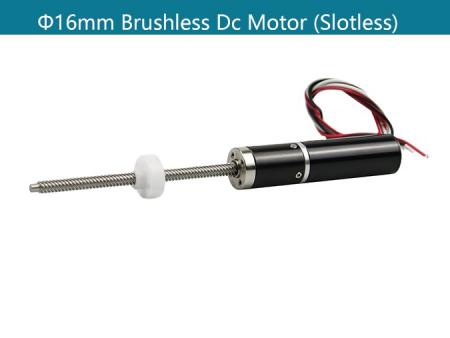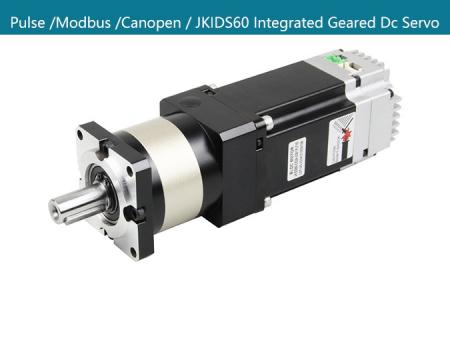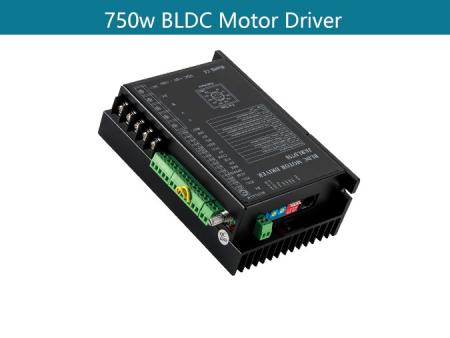In the world of electric motors, the debate between Brushed DC motors and brushed motors is a prominent one. Each type of motor has its unique advantages and applications. To determine which is better, it's essential to understand the fundamental differences, benefits, and drawbacks of both. This article provides a comprehensive comparison to help you make an informed decision.
 |  |  |  |  |
| 24v 36v regular / or customized | 24V 36V / or customized | 24V 36V / or customized | 48V / or Customized | 48V / or Customized |
| Gearbox / Brake / Encoder / Driver / Shaft Customized | Gearbox / Brake / Encoder / Integrated Driver / Shaft Customized | Gearbox / Brake / Encoder / Integrated Driver / Shaft / Fan Customized | ||
| 42mm Round Brushless Dc Motor | 42mm Square Brushless Dc Motor | 57mm Brushless Dc Motor | 60mm Brushless Dc Motor | 80mm Brushless Dc Motor |
| / | IDS42 Integrated Servo Motor | IDS57 Integrated Servo Motor | IDS60 Integrated Servo Motor | IDS80 Integrated Servo Motor |
 |  |  |  |  |
| 48V / or Customized | 310V / or Customized | Coreless Dc Motors | IDS Integrated Servo Motors | Brushless Dc Motor Driver |
| 86mm Brushless Dc Motor | 110mm Brushless Dc Motor | |||
| / | / | |||
Brushed motors are the traditional type of DC motors. They consist of four main components: the stator, rotor, commutator, and brushes. The stator provides a static magnetic field, while the rotor, also known as the armature, rotates within this field. Brushes, made of carbon or graphite, make contact with the commutator to conduct electricity and create the necessary magnetic field in the rotor, causing it to turn.
Brushed DC motors have a simple and straightforward design. They consist of basic components: the stator, rotor, commutator, and brushes. This simplicity translates into ease of understanding, manufacturing, and repair.
The uncomplicated design of brushed DC motors makes them easy to use. They do not require sophisticated electronic controllers for operation, which simplifies the overall system design and implementation.
Brushed DC motors are generally less expensive to manufacture and purchase compared to brushless motors. The materials and components used in their construction are readily available and cost-effective, making them an economical choice for many applications.
The maintenance of brushed DC motors, while necessary, is relatively simple and inexpensive. Replacing worn-out brushes is a straightforward task that does not require specialized skills or tools, keeping maintenance costs low.
One of the standout features of Brushed DC motors is their ability to deliver high starting torque. This characteristic is particularly beneficial in applications where a strong initial force is required to start motion, such as in cranes, conveyors, and electric vehicles.
Brushed DC motors provide consistent torque across a wide range of speeds, including low speeds. This makes them suitable for applications requiring stable and reliable performance at varying speeds.
Controlling the speed of Brushed DC motors is straightforward and can be achieved with simple voltage adjustments. This ease of control makes them ideal for applications where precise speed regulation is not critical but simplicity and reliability are essential.
The controllers used for brushed DC motors are generally less complex and less expensive than those required for brushless motors. This reduces the overall cost of the motor control system, making it an economical choice for budget-sensitive applications.
Brushed DC motors have a long history of reliable performance in various applications. Their robust construction and proven design ensure that they can withstand demanding operating conditions and continue to perform reliably over time.
The durable nature of brushed DC motors allows them to operate effectively in harsh environments. They can withstand dust, dirt, and moisture, making them suitable for industrial and outdoor applications.
The components used in Brushed DC motors are widely available and standardized. This widespread availability ensures that parts are easy to source, and replacements can be quickly obtained, reducing downtime in the event of a failure.
Brushed DC motors are compatible with a wide range of existing systems and equipment. Their standard design and operation principles mean they can be easily integrated into various applications without requiring significant modifications.
Brushed DC motors are versatile and can be used in a wide range of applications, from household appliances and automotive systems to industrial machinery and robotics. Their adaptability makes them a go-to choice for many different industries.
The straightforward design of brushed DC motors allows for easy customization to meet specific application requirements. Modifications can be made to the motor's size, winding configuration, and other characteristics to optimize performance for particular tasks.
Brushed DC motors continue to offer significant advantages that make them a valuable option in various applications. Their simplicity, cost-effectiveness, high starting torque, ease of control, robust construction, wide availability, and versatility ensure they remain a relevant and reliable choice in many industries. By understanding these advantages, you can better appreciate the enduring appeal of brushed DC motors and make informed decisions about their use in your projects.
While Brushed motors are still widely used and appreciated for their simplicity and cost-effectiveness, they also come with several drawbacks that can limit their application in certain scenarios. Understanding these disadvantages is crucial for making informed decisions when selecting a motor for your specific needs. Below, we delve into the key disadvantages of brushed motors.
Brushed motors rely on brushes to make contact with the commutator, enabling current to flow through the motor. These brushes wear down over time due to friction, necessitating regular inspection and replacement. This wear and tear can lead to increased downtime and maintenance costs.
The need for regular brush replacement and commutator cleaning means that brushed motors require more frequent servicing compared to brushless alternatives. This can be particularly problematic in applications where continuous operation is critical.
The friction between the brushes and the commutator generates heat, leading to energy losses. This reduces the overall efficiency of brushed motors, making them less energy-efficient compared to brushless motors.
The heat generated by the friction not only reduces efficiency but can also affect the motor's performance and lifespan. Excessive heat can lead to overheating, requiring additional cooling solutions and increasing the complexity and cost of the system.
Brushed motors use mechanical commutation, which can limit the precision of speed and torque control. This can be a significant drawback in applications requiring high levels of control and accuracy, such as robotics and advanced manufacturing processes.
As the brushes wear down, the performance of brushed motors can fluctuate. This can lead to inconsistencies in speed and torque output, which may be unacceptable in certain applications where stability and reliability are crucial.
The mechanical contact between the brushes and the commutator generates noise and vibration. This can be a disadvantage in applications where quiet operation is essential, such as in medical equipment, consumer electronics, and precision instruments.
The noise and vibration produced by brushed motors can also interfere with other components and systems, potentially leading to operational disturbances and reduced overall system performance.
The wear and tear on brushes and the commutator lead to a shorter lifespan for brushed motors compared to their brushless counterparts. The constant friction and mechanical stress can degrade the components faster, necessitating more frequent replacements.
The mechanical components in brushed motors are more prone to failure, which can reduce their overall reliability. This is a critical consideration for applications where long-term dependability and minimal downtime are essential.
Brushed motors can be more sensitive to environmental factors such as dust and debris. The brushes and commutator are exposed to the environment, which can lead to contamination and accelerated wear.
Exposure to moisture and corrosive environments can further degrade the brushes and commutator, reducing the motor's lifespan and performance. This limits the use of brushed motors in harsh or demanding conditions without additional protective measures.
At high speeds, the commutator can spark due to the rapid switching of current between the brushes and commutator segments. This sparking not only generates noise and electromagnetic interference but can also damage the motor over time.
The mechanical nature of Brushed DC motors imposes constraints on their maximum speed. High-speed operation can lead to increased wear, overheating, and reduced motor lifespan, making brushed motors less suitable for high-speed applications.
While brushed motors offer several advantages, including simplicity and cost-effectiveness, their disadvantages must be carefully considered. High maintenance requirements, lower efficiency, limited speed and torque control, noise and vibration, shorter lifespan, environmental sensitivity, and constraints in high-speed applications are significant drawbacks. By understanding these disadvantages, you can make more informed decisions about whether a brushed motor is the right choice for your specific needs.
Brushed DC motors, as the name suggests, operate without brushes. They consist of a stator with windings and a rotor with permanent magnets. Instead of brushes and a commutator, an electronic controller is used to manage the current flow through the windings, creating a rotating magnetic field that turns the rotor.
Brushless DC motors, or Bldc Motors, have become increasingly popular due to their numerous advantages over traditional brushed motors. These advantages make them ideal for a wide range of applications, from consumer electronics to industrial machinery. Below, we explore the key benefits of brushless DC motors in detail.
Bldc Motors are known for their high efficiency. The absence of brushes eliminates the friction and energy loss typically associated with brushed motors. This means that more electrical energy is converted into mechanical power, resulting in less heat generation and higher overall efficiency.
The improved efficiency of Bldc Motors leads to significant energy savings, particularly in applications requiring continuous operation. This makes them a preferred choice for electric vehicles, HVAC systems, and other energy-intensive applications.
One of the most significant advantages of Bldc Motors is the absence of brushes. Brushes in traditional motors wear out over time due to friction, requiring regular replacement and maintenance. With no brushes to worry about, BLDC motors require significantly less maintenance, reducing downtime and operational costs.
The elimination of brushes also means that there are fewer components subject to wear and tear. This results in a longer lifespan for BLDC motors, making them more reliable and cost-effective over time.
The robust design of Bldc Motors, with fewer moving parts, enhances their durability. They can withstand harsh environments and are less prone to mechanical failures, making them ideal for industrial and demanding applications.
BLDC motors provide consistent performance over their lifespan. The electronic commutation ensures that the motor operates smoothly without the fluctuations that can occur in brushed motors due to brush wear.
Bldc Motors use electronic controllers for commutation, allowing for precise control of speed and torque. This is particularly beneficial in applications requiring variable speeds and high precision, such as robotics, CNC machines, and advanced manufacturing processes.
The ability to maintain consistent torque over a wide range of speeds makes Bldc Motors versatile for various applications. This wide speed range capability is essential for applications like electric propulsion and automation systems.
The absence of brushes eliminates the mechanical contact between brushes and the commutator, significantly reducing noise and vibration. This quieter operation makes Bldc Motors suitable for applications in noise-sensitive environments, such as medical equipment and consumer electronics.
Bldc Motors offer a high power-to-weight ratio, meaning they can deliver more power without increasing the motor's size and weight. This high power density is crucial in applications where space and weight are at a premium, such as in drones, electric vehicles, and portable devices.
The integration of advanced electronics in Bldc Motors allows for additional features such as smart diagnostics, real-time monitoring, and adaptive control. These features enhance the motor's performance, reliability, and integration with modern control systems and the Internet of Things (IoT).
Bldc Motors can be easily customized to meet specific application requirements. Manufacturers can tailor the motor's characteristics, such as winding configurations and controller settings, to optimize performance for particular tasks.
The advantages of brushless DC motors make them an attractive choice for a wide range of applications. Their higher efficiency, low maintenance, improved durability, precise control, quieter operation, enhanced power density, and advanced features position them as a superior alternative to traditional brushed motors. As technology continues to advance, the benefits of BLDC motors will only become more pronounced, driving their adoption across various industries.
While Brushed DC motors (BLDC motors) offer numerous advantages over traditional brushed motors, they also come with certain drawbacks. Understanding these disadvantages is crucial for making informed decisions when selecting a motor for a specific application. Below, we explore the key disadvantages of brushless DC motors in detail.
The manufacturing process of Bldc Motors is more complex than that of brushed motors. This complexity arises from the need for precise electronic components and permanent magnets, which increases production costs. As a result, BLDC motors typically have a higher initial purchase price.
The use of rare earth magnets, such as neodymium, in the rotor construction adds to the cost. These materials are more expensive than the components used in brushed motors, contributing to the overall higher price of BLDC motors.
Brushed DC motors require sophisticated electronic controllers to manage the commutation process. These controllers must be designed to precisely control the current flow through the motor windings, which adds complexity to the system.
The need for advanced electronic controllers also increases the overall cost of the motor system. These controllers are often more expensive than the simple controllers used for brushed motors, adding to the initial investment required.
BLDC motors, particularly those with rare earth magnets, can be sensitive to high temperatures. Excessive heat can demagnetize the magnets, reducing the motor's performance and efficiency. Proper thermal management is essential to ensure reliable operation.
The performance of Bldc Motors can be affected by external magnetic fields. In environments with strong magnetic interference, additional shielding or careful placement may be necessary to maintain motor performance.
Repairing and maintaining Bldc Motors can be more challenging than dealing with brushed motors. The advanced electronics and precise components require specialized skills and knowledge for troubleshooting and repairs. This can increase maintenance costs and complicate in-field repairs.
Due to the complexity and specialized nature of Bldc Motors, replacement parts may be less readily available compared to those for brushed motors. This can lead to longer downtimes if a motor needs repair or component replacement.
Bldc Motors rely heavily on electronic components for their operation. If any part of the electronic control system fails, the entire motor can become inoperative. This dependence on electronics introduces a potential point of failure that is not present in simpler brushed motors.
Diagnosing issues with Bldc Motors can be more complicated due to the integrated electronic components. Advanced diagnostic tools and techniques are often required to identify and resolve problems, which can increase maintenance time and costs.
Setting up and tuning a Bldc Motor for optimal performance requires careful configuration of the electronic controller. This process can be time-consuming and requires a good understanding of motor control principles. Incorrect setup can lead to suboptimal performance or even damage to the motor.
To achieve precise control, Bldc Motors often need to be calibrated. This calibration process can be intricate and may require specialized equipment and expertise, adding to the initial setup time and cost.
While brushless DC motors offer significant advantages in terms of efficiency, reliability, and performance, they also present certain disadvantages that must be considered. The higher initial cost, requirement for sophisticated electronic controls, sensitivity to environmental factors, complexity in repairs and maintenance, potential for electronic failures, and the complexity of initial setup and tuning are all factors that can impact their suitability for specific applications. By carefully weighing these disadvantages against the benefits, you can make an informed decision about whether a BLDC motor is the right choice for your needs.
Brushless motors typically offer higher efficiency and performance compared to brushed motors. The elimination of brushes reduces friction and energy loss, resulting in better energy conversion and less heat generation. This makes brushless motors more suitable for applications where efficiency is crucial, such as electric vehicles and high-performance machinery.
Brushed DC motors require regular maintenance to replace worn-out brushes, which can lead to increased downtime and maintenance costs. In contrast, brushless motors are virtually maintenance-free, thanks to their brushless design. This makes them ideal for applications where continuous operation and reliability are essential.
While brushed motors are less expensive initially, the long-term operational costs due to maintenance and energy inefficiency can outweigh the initial savings. Brushless motors, despite their higher initial cost, offer long-term savings through reduced maintenance and higher efficiency.
Ideal for applications where simplicity, low cost, and high torque at low speeds are required. Examples include basic household appliances, simple industrial machinery, and low-cost power tools.
Suitable for applications demanding high efficiency, reliability, and precise control. Examples include electric vehicles, drones, advanced robotics, and high-end power tools.
In the debate of brushless motors versus brushed motors, the choice largely depends on the specific requirements of the application. Brushless motors are generally superior in terms of efficiency, maintenance, and performance, making them the preferred choice for many modern and demanding applications. However, brushed motors still hold value in scenarios where simplicity and low initial cost are prioritized.
View More(Total0)Comment Lists